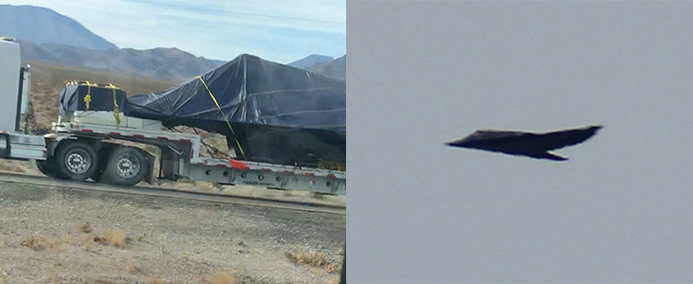Some F-117s have already taken the road to the scrapyard, others continue flying. Enjoy your Black Friday with a Black Jet story.
As already reported, an F-117 Nighthawk was spotted on a trailer on US-95, south of Creech AFB, in southern Nevada, on Nov. 13, 2017.
Although we don’t know exactly where the aircraft was being transferred, it is safe to assume the aircraft might be heading to the boneyard, to be scrapped or prepared for a museum.
Indeed, in accordance with the National Defense Authorization Act of 2017, the USAF will retire the fleet permanently, once and for all.
Actually, the U.S. Air Force will not remove all the F-117s this year: one aircraft will be divested by the end of 2017 (possibly the one on the trailer); the rest will be withdrawn from use at a rate of four every year, beginning in 2018.
So, whilst the final “demilitarization” of the Stealth Jet (officially retired in 2008 but maintained and kept in a “Type 1000” storage to be occasionally flown at Tonopah Test Range until today) is a sad news for aviation enthusiasts all around the world, the fact that not all the F-117s have been permanently retired means that there will probably be a few more chances of watching the Black Jet fly somewhere over Nevada (or somewhere else).
As happened on Nov. 14 (the day after the F-117 was photographed on a trailer south of Creech AFB) at 09.20AM LT, when another F-117 was spotted flying north of Rachel, Nevada. Noteworthy, the Stealth Jet was not flying alone (or close to another F-117, as happened, for instance, in 2016) but it was chased by a two-seater F-16.
Our friend G. from the outstanding lazygranch.com website shot some interesting photographs of the unusual formation. “The image is backlit, but the plane shapes are distinctive enough to identify the type of aircraft” he wrote in his post. Indeed, the photos lack a bit of quality (it would have been interesting to ID the F-16 by the presence of some particular markings or code), but according to G. there’s a reason for this:
I had used the camera to do long exposure photography as in this web page: http://www.lazygranch.com/letap.html
This time I had used the 400mm lens instead of the 200mm lens I used in the letap.html page. I managed to kill 4 camera batteries doing this. The problem was the freezing weather was effecting the battery life.
The 400mm lens was essentially set up to focus at infinity. In these multi-frame long exposure series of photographs, the lens is left in manual focus since there is nothing in the frame to auto focus on. The camera is initially focused by hand to get the sharpest image of the lights on Papoose Mountain, which are the lights on the mountain in the distance. Papoose Mountain is what you see as a background in the base photographs done from Tikaboo Peak.
I had one poor quality camera battery left. I normally don’t use it because it only charges to about 55%. I had left the 400mm lens in manual focus. When I heard the aircraft, I put in the poor quality battery. The planes were far enough away that the EOS system considered them to be sharp enough to allow the images to be taken. When the planes flew north so that the sun was in a better position and the planes were closer, the camera wouldn’t fire. I missed some great shots. That was when I figured out the lens was left on manual focus.
Eventually, G. added an interesting comment to his post: “Groom Lake uses two seater F-16s”.
Therefore, although the Air Force has started retiring the type (again), it’s nice to see that someone is still enjoying a daylight ride in one of the once most secret and futuristic aircraft ever built. The accompanying F-16 makes the sighting even more interesting…
Visit this link and let me know what you think.
Above: composite photo made using a crop from a Foster VS taken in 2014 and one of the screenshots from a video filmed by Randy Williams and made available to The Aviationist by Brett Wyman.









